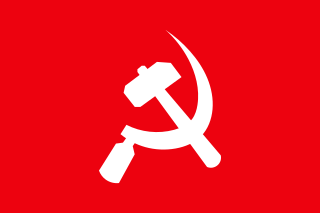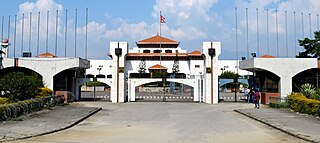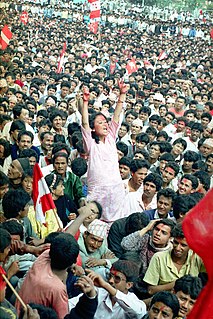
The politics of Nepal functions within the framework of a parliamentary republic with a multi-party system. Executive power is exercised by the Prime Minister and his/her cabinet, while legislative power is vested in the Parliament.

The Nepali Congress is a social-democratic political party in Nepal. It is the largest opposition party in the House of Representatives and the National Assembly.

The Nepalese Civil War was a protracted armed conflict that took place in Nepal between the Communist Party of Nepal (Maoist) (CPN-M) and the Government of Nepal from 1996 to 2006. The conflict period is known as the Saśastra Dvandvakāla in Nepal.

The Communist Party of Nepal was a communist political party in Nepal from 1949 to 1962. It was founded on 15 September 1949 to struggle against the autocratic Rana regime, feudalism and imperialism. The founding general secretary was Pushpa Lal Shrestha. Other members were Nar Bahadur Karmacharya, Niranjan Govinda Baidhya, and Narayan Bilas Joshi.

The Communist Party of Nepal is a communist political party in Nepal. It was founded in 1994 after breaking away from the Communist Party of Nepal. The party has led three governments, from 2008 to 2009 and from 2016 to 2017 under Pushpa Kamal Dahal and from 2013 to 2015 under Baburam Bhattarai.

The Communist Party of Nepal is one of the major communist parties in Nepal since its formation in January 1991, merging the Communist Party of Nepal (Marxist) and the Communist Party of Nepal (Marxist–Leninist).

The Nepal Workers and Peasants Party (NWPP) or Nepal Majdoor Kisan Party is a political party in Nepal. The party was founded on 23 January 1975 by Narayan Man Bijukchhe. The party enjoys most of its support from Bhaktapur. The party is sympathetic to the Workers' Party of Korea in North Korea, as well as the Juche ideology.

Communist Party of Nepal (Masal), was a communist party in Nepal. CPN (Masal) was formed in 1983, following a split in the Communist Party of Nepal. The party was led by Mohan Bikram Singh.

Communist Party of Nepal (Burma), initially known simply as Communist Party of Nepal or Communist Party of Nepal , was a communist party in Nepal. The party emerged from a split in the original Communist Party of Nepal in 1962, representing the pro-Soviet sector of the party. Its main leader until 1983 was Keshar Jung Rayamajhi, who had been the general secretary of the original CPN.

Nepal RatnaMadan Kumar Bhandari, commonly known as Madan Bhandari, was a popular Nepali political leader belonging to the Communist Party of Nepal, a democratic communist party in Nepal. He defeated the incumbent Prime Minister Krishna Prasad Bhattarai in the 1991 general election. Known for his charismatic style, Bhandari had propounded the popular communist principle or thought "People's Multiparty Democracy". He is widely regarded for peaking the Nepal's communist movement to a greater height. He died in a jeep accident in Dasdhunga, Chitwan, in 1993.

Nepal Communist League was a communist organisation in Nepal. NCL was led by Shambhuram Shrestha. Shrestha, who had been a central secretariat member of the original Communist Party of Nepal, broke away from Man Mohan Adhikari's faction in the mid-1970s.
General elections were held in Nepal on 15 November 1994 to elect the Nepal House of Representatives. The election took place after the previous Nepali Congress government collapsed and King Birenda called new elections. The results saw the Communist Party of Nepal win the most seats in the House of Representatives and Man Mohan Adhikari became Prime Minister at the head of a minority government.

The United Left Front was an alliance of communist parties that opposed the autocratic regime in Nepal. It was formed in 1990 and conducted joint movement with the Nepali Congress. The uprising, called Jana Andolan, brought to an end of monarchic dictatorship and led the way for multiparty elections.

The Nepalese democracy movement is a series of political movements from the 20th century to 2008 that advocated the establishment of representative democracy, a multi-party political system and the abolition of monarchy. It has seen three major movements, the Revolution of 1951, Jana Andolan and Loktantra Andolan which ultimately abolished the Shah monarchy, transitioned Nepal towards a republic and reintroduced multi-party bicameral democracy.

The 1990 People's Movement was a multiparty movement in Nepal that brought an end to absolute monarchy and the beginning of constitutional monarchy. It also eliminated the Panchayat system.
Pushpa Lal Shrestha was a Nepali politician, considered to be the father of Nepali communism. He was the founding general secretary of the Communist Party of Nepal as well as leader.

The All Nepal National Free Students' Union is a political student organization in Nepal. The ANNFSU was founded in 1965. The original ANNFSU was later divided along ideological lines, and there are several organizations that emerged from it. The main ANNFSU grouping today is politically tied to the CPN (UML). As well as declaring itself a legitimate and independent students' organization of all progressive, democratic and patriotic students of Nepal, the mainstream ANNFSU is currently a member of the World Federation of Democratic Youth.
Ruplal Bishvakarma was a Nepalese communist politician, peasant leader and Dalit activist. Ruplal hailed from a middle peasant family in the Chitwan district. Something of an oddity amongst Nepalese communist leaders.

Ram Chandra Ba or Ram Chandra Paudel is a Nepalese politician who served as Deputy Prime Minister and Speaker of the House of Representatives of Nepal. He is the senior leader of the Nepali Congress. He is popularly called as ‘Ram Chandra Dai’ by fellow Nepali Congress Cadets.

Communism in Nepal traces its roots back to the pro-democracy movement of 1951, and the subsequent overthrow of the autocratic Rana regime and the establishment of democracy in Nepal. The communist movement in Nepal has split into factions multiple times and multiple factions have come together into a single fold at times as well. It has a history of getting banned from open political discourse; as well as multiple instances of embracing guerrilla insurgency, most notably, the Maoist insurgency in the 1990s and early 2000s that led to the Nepalese Civil War, claiming at least 17,000 lives. After the Maoists and other main political parties formed a united coalition, launching a successful peaceful civil resistance against the dictatorial coup d'état by the monarchy, which resulted in the abolition of the monarchy and drafting of a new constitution affirming Nepal as a secular, federal, democratic republic striving towards democratic socialism, the two main communist parties of Nepal contested the first election according to the new constitution as a coalition, eventually leading to the unification of two parties with a strong majority in the federal parliament as well as six out of seven provinces of Nepal.











